






On average, a new motorcycle rolls off the assembly line at BMW Motorrad’s plant in Spandau, on the outskirts of Berlin, every 60 seconds. During peak production times, that’s an astonishing 1,000 bikes a day. When Bayerische Motoren Werke (Bavarian Motor Works) celebrates its 100th anniversary of production in 2023, it will have manufactured some three million motorcycles since the company’s first machine—the R32 “boxer twin”—was introduced at the Paris Salon in 1923.
In 2021, BMW sold a record 194,261 motorcycles, with the distinctive and classic flattwin boxer models accounting for around half of the total. From powering the relatively simple yet technologically advanced 494cc R32 of 1923 to the retro-futuristic, state-ofthe-art 1,802cc R18 (the highest displacement boxer that BMW has ever built) introduced in 2023 for the company’s production centenary, the iconic horizontally opposed twincylinder “airhead boxer” engine has become so synonymous with the legendary German marque that no other motorcycle manufacturer has attempted to copy it. In fact, the timeless and versatile boxer became so beloved that it met huge resistance among the company’s client base in the 1980s when BMW tried to replace it.
Proving itself (and improved upon) every year, the brand’s defining hallmark motor has ever since remained as deliberately close to the original as possible. Of course, BMW has introduced singles (as early as 1925), as well as inline fours and sixes (launched with the K series in 1993) and even four-cylinder transversely mounted engines (with the S and M series sports bikes introduced in 2009). But the amazingly versatile boxer twin has consistently remained at the heart of the company’s entire model range to this day.
The iconic “airhead” twin gained a massive boost in popularity in 1980 with the launch of the ground-breaking, dual-purpose R80 G/S (Gelände/Straße) model. Considered to be the world’s first true “adventure bike,” the G/S proved equally capable on and off the road, and it quickly launched an entire new concept of long-distance adventure travel. BMW has since set the international benchmark in the adventure market, boosted by early top-of-the-podium wins in the Paris-Dakar (the most demanding rally in the world) and by such round-the-world journeys as those of Helge Pedersen, Elspeth Beard, Sam Manicom, and (in 2004) actors Ewan McGregor and Charley Boorman for the BBC’s Long Way Round TV program.
So successful has BMW’s enduro (off-road) segment become that its top-ofthe-line G/S and G/S Adventure series today accounts for one-third of the German company’s entire annual motorcycle production, with more than 60,000 sold in 2021. Many manufacturers produce faster motorcycles. Most make cheaper bikes. But no other manufacturer can lay claim to combining such consistent practicality, versatility, quality, and reliability as BMW. “The BMW is famous for not giving mechanical problems on the road and that’s what he is counting on,” recalled Robert Pirsig in Zen and the Art of Motorcycle Maintenance, regaling his 1968 across-the-USA road trip with his mechanically fearful friend John Sutherland at a time when BMW motorcycles were still relatively rare in North America. From their inception, BMWs were also significantly more expensive than competing marques, but their premium price was (and remains) justified by their undisputed reputation for quality, reliability, and innovative engineering—traits that have maintained the company as the motorcycle industry’s foremost leader.
It’s an astonishing success story for a company than began a century ago as a merger between two aircraft engine manufacturers in Munich. (Contrary to popular myth, the BMW badge does not represent a spinning propeller; it combines the Bavarian colors of white and blue inside the black ring logo of Rapp Motorenwerke.) BMW’s reputation for unparalleled design and build quality owes much to its roots in the precision-conscious aviation industry. Its reputation for also building bikes that are both extremely functional and a sheer joy to ride owes much to Bayerische Motoren Werke being situated in the shadow of the Bavarian Alps. Since the outset, BMW motorcycles have excelled in the twisting back roads of the Bavarian countryside and, since the 1930s, the more sporting realm of the German Autobahn.
A seminal evolution came in 1969 with the introduction of the /5 series (500cc R50/5, 600cc R60/5, and 750cc R75/5), using the most significantly updated boxer engine in three decades. The R75/5 could reach 177 km/h (110 mph), still far short of the blistering 200 km/h (125 mph) Honda CB750 and other four-cylinder Japanese motorcycles that had begun to dominate the European and US markets. The 898cc R90S (1973), however, had a top speed of 200 km/h (124 mph), and with its elegant looks (including bikini fairing and sexy airbrush paint scheme) reestablished BMW at the forefront of motorcycling’s mainstream after two decades in which the German marque failed to capture the public’s imagination.
R90Ss even finished first and second in the first AMA Superbike race at Daytona in 1976 before winning that year’s AMA Superbike Championship. With a four-cylinder, in-line 999cc engine and top speed of 360 km/h (224 mph), BMW’s current flagship superbike—the 205hp S1000RR—is leagues apart from the edgy, cool, race-winning R90S. Yet the race-ready, multiple TT winner is merely the latest German wonder machine in BMW’s early tradition (since 1925, with the R37) of offering aggressively agile sporting models alongside their more sensible, even plain, workhorse boxer tourers.
The 1983 introduction of the in-line, four-cylinder “flying brick” K bikes vastly broadened BMW’s market appeal, adding to the massive boost generated since 1980 by the dual-sport G/S series. In 1993, the airhead boxer engine that had served since 1923 was finally replaced by a state-of-the-art oil-cooled boxer engine (introduced in the R1100RS sports tourer) that further bolstered BMW’s sales. By the millennium, BMW’s sales in the United States rivaled those of all other European motorcycle manufacturers combined. In Europe, the German marque was firmly preeminent. Today, BMW Motorrad’s remarkably diverse 36-model lineup spans fun roadsters in four engine types; eight adventure bikes (from the BMW G310GS single to the R1250GS Adventure boxer); seven full-bagged tourers, crowned by the ultra-luxurious BMW K1600GTL; seven hypersonic sport and racing superbikes for the absolute philistine thrill; and ten Heritage bikes, highlighted for 2023 by the glamorous, limited edition BMW retro-themed R18 100 Years classic.
Fifty of the most iconic models are profiled in this tribute to a century of BMW excellence.
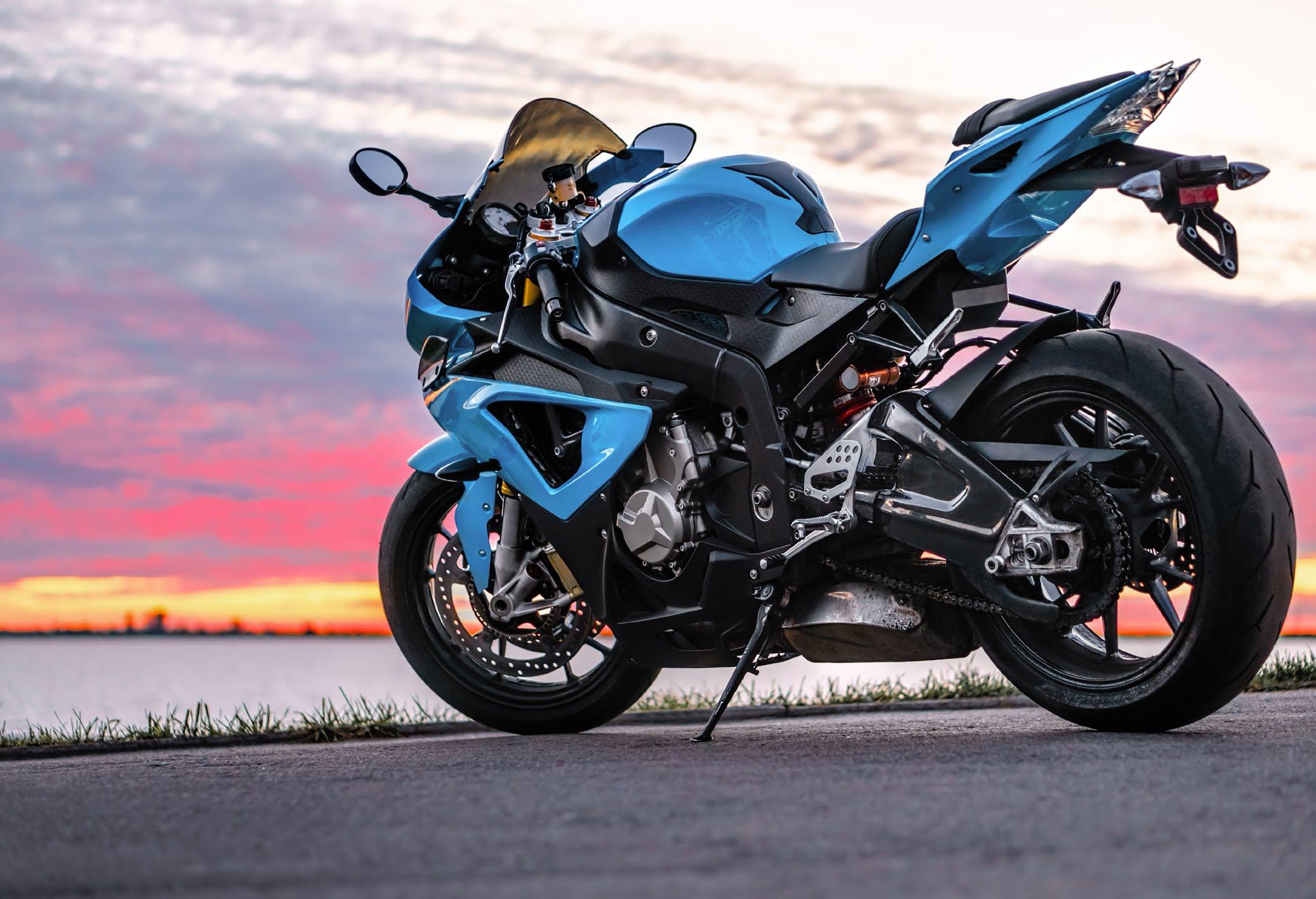




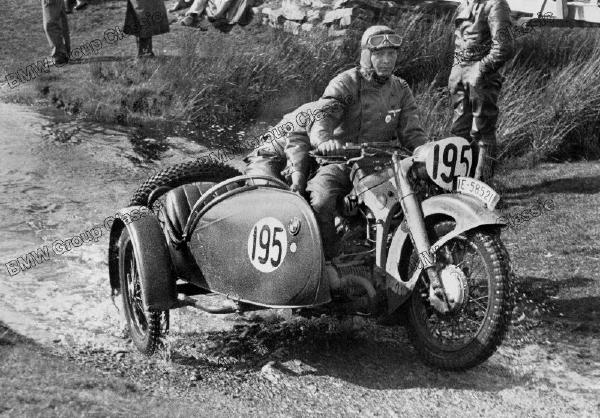
The BMW legend begins in Munich in 1916 with the merger of aircraft manufacturer Otto-Werke and aircraft engine manufacturer Rapp Motorenwerke to create the Bayerische Flugzeugwerke GmbH (Bavarian Airplane Works, or BFW). In 1913, Germany and Austria were preparing for conflict with the Entente Powers and had placed a large order with Rapp for aircraft engines. Karl Friedrich Rapp’s business expanded rapidly, but his engines delivered poor performance and were unreliable. The German War Ministry rejected them. The Imperial Austro-Hungarian Army Administration, however, assigned Rapp to manufacture the Austro-Daimler V12 engine under license and appointed Franz Josef Popp to oversee quality control on behalf of the Austrian War Ministry.
Popp soon became involved in running the company, and after Rapp resigned due to ill health in October 1917, he was appointed managing director and the company was reorganized as Bayerische Motoren Werke GmbH (BMW). Popp quickly employed a young Daimler engineer—Max Friz—to design a powerful, high-altitude aero engine. Friz’s innovative “overcompressed” 185-horsepower overhead cam, inline six-cylinder BMW IIIa engine featured an altitude-adjusting carburetor that produced a dramatic increase in climb rate and speed at high altitude. It was soon winning dogfights for the Fokker D.VII (Germany’s finest World War I fighter plane), earning BMW a reputation for quality it has maintained to the present day.

“My loyal sports comrade—the B.M.W. 750 cc. reads this advertisement in the March 1929 issue of Motor und Sport (Motor and Sport) magazine.
Instead of a headlight it features an oversize BMW logo.

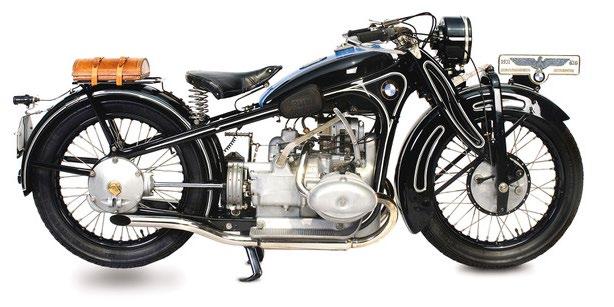
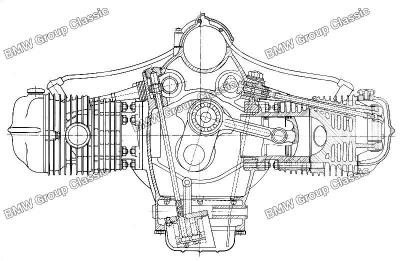
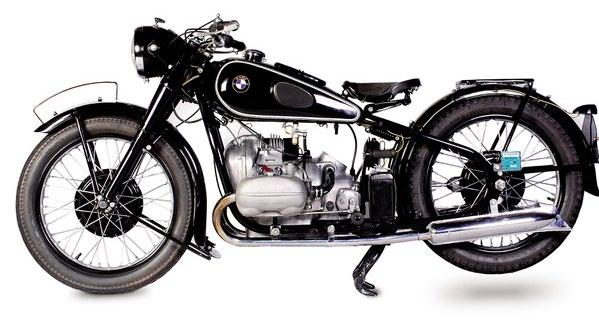
By 1936, BMW was already heavily invested in military motorcycle production. But one look at the R5 reveals that the company’s engineers were capable of producing one of the most advanced bikes of the decade while also serving the “keep-it-simple” needs of the Wehrmacht. The innovative R5 was BMW’s first new 500cc sports model in six years, and despite its short life, it was a sensation and destined to be one of the great bikes of its decade. Its creator, BMW engineer Rudolf Schleicher, considered it his most important design.
For one, its forward-leaning styling seemed two decades ahead of its time. Its sophisticated “1950s” look was defined by a new elliptical twincradle frame of arc-welded oval-shaped tubes. Adapted directly from BMW’s racing machines, it offered exceptional torsional stiffness. It was also much lighter than the pressed-steel frames of earlier models: the R5 tipped the scales at a modest 165 kg (363 lbs).
The R5’s cutting-edge features included the state-of-the-art telescopic forks with hydraulic damping adjustment first seen on Alfred Böning’s sensational R7 concept bike. Front-wheel travel was limited. And rear suspension was still limited to the sprung saddle from the R7 concept bike (in 1938, the plunger rear suspension developed on the race machines was finally added to the R5—and the bike was renamed the R51). But the new front suspension greatly improved wheel control, roadholding, and the bike’s overall nimble and sporty handling. It was a charm to ride.

The R5 received a complex new race-proven version of the familiar 494cc OHV boxer-twin powerplant cased, for the first time, in a singlecast housing. The all-new engine with advanced tunnel crankcase kept the traditional square 68mm bore x 68mm stroke and retained overhead valves, now actuated by twin chain-driven camshafts. This allowed for more advantageous valve angles and shorter pushrods, which combined with new hairpin valve-springs from BMW’s race bikes to produce higher revs. New cylinder head assemblies included rocker arm bearings cast into the heads. The cylinders each breathed through its own Amal S/423 carburetor. With a compression ratio of 6.7:1, power output was an impressive 24hp at 5,500rpm, and its top speed of 135 km/h (84 mph) rivaled that of BMW’s 750cc models.
England’s Velocette had first introduced a positive-stop foot-operated gearshift in 1928. With the R5, it made its BMW debut as a left-side shift lever for the four-speed transmission. (It also featured an archaic handshift lever sprouting on the right side of the transmission case, which unfathomably survived through 1955.)
By far BMW’s most advanced motorcycle to date, priced at 1,550 Reichsmarks it cost less than the R57, the company’s last 500cc sports model, which ended production in 1929. Despite representing excellent value, only 2,652 had been sold when production ceased in 1937 to make way for the R51, with its new rear suspension.




In the summer of 1950, the American occupying forces lifted the restriction on production of motorcycles above 250cc. As for the R24, BMW engineers tore down surviving pre-war R51 motorcycles and using the measurements for every component, rebuilt and revised it as the R51/2.
The original 494cc OHV machine was state-of-the-art when launched in 1938. BMW updated the chassis and engine and confidently presented the new 500cc-class boxer twin in March 1950 at the Geneva International Motor Show, and that August at the Chicago Trade Fair.
Visually, little distinguished the R51/2 from its progenitor. It used the same electrically welded, oval-section tubular steel frame, but with two additional strengthening tubes. And the front telescopic fork now had two-way hydraulic damping. The R51/2’s engine was also virtually identical to the original prewar motor, except for new cylinder heads that now had coil valve springs, plus split valve covers (echoing those of the R75) and a coil-spring damper on the gearbox mainshaft. Twin 22mm Bing Spezial carburetors replaced the Amals. And a revised lubrication system improved flow of pressured oil to the camshaft bearings and cylinder heads.
As with all boxer tourers, the R51 frame featured attachment points that permitted sidecar use. The R51/2 proved popular when fitted with Steib’s eye-catching, single-seat, Zeppelin-like Standard sidecar built to BMW’s specifications with a leather-covered passenger compartment and full windscreen. From almost the company’s very founding, BMW built sturdy, black side-rigs suited to their torquey, low-compression twin-cylinder tourers.

The R80ST was a street-oriented sibling based on the R80G/S, but with smaller, more street-friendly 19-inch wheels, plus shorter handlebars, forks, and suspension travel.


The advent of the K series would soon sound the death knell for BMW’s 1,000cc boxer twins. The R80G/S was the only boxer to survive intact, becoming the inspiration and mold for the last series of air-head twins. Meanwhile, the 1981 R100 series (with four models: the R100, R100RT, R100RS, and R100CS replacing the R100S) got the improved 70-horsepower A10 boxer engine plus an upgraded Bosch electronic system, including electronic ignition. The sporty cockpit-faired R100CS was now the fastest BMW motorcycle of its time, with a top speed of 200 km/h (124 mph). Many of the improvements to the R100 series were carried over to the competent (yet still underpowered and expensive) 1981 model year R45 and R65 middleweights.

The boxer twins received few changes for 1982 as BMW focused its resources on developing the K series. But a new and racier-looking model—the controversial R65LS—was introduced. Its sharp-angled, fork-mounted spoiler, radical composite cast wheels, plus black-painted exhaust and garish color scheme seemed ostentatious. By BMW standards, it seemed a bit of a cheap “parts bin special.” The entry-level bike flopped with consumers. The pricey road-going R80ST (a pure street version of the R80G/S) and fully faired budget R80RT tourer, also introduced in 1982, likewise failed to sell. But BMW needn’t have worried. In 1983, it finally released the first transformative K models with longitudinal four-cylinder in-line engine. This new generation of motorcycles would secure BMW’s future for the coming decades.


That year, it also introduced its first all-electric bike, the CE04 commuter scooter, styled as if for a sci-fi movie. The electrified future had arrived as Markus Schramm, head of BMW Motorrad, announced that by 2025, other model series would be powered by batteries derived from BMW’s i series electric cars.
In 2022, BMW Motorrad achieved the highest sales in its corporate history, topping 200,000 two-wheelers for the first time. For 2023, its centenary year looked golden.

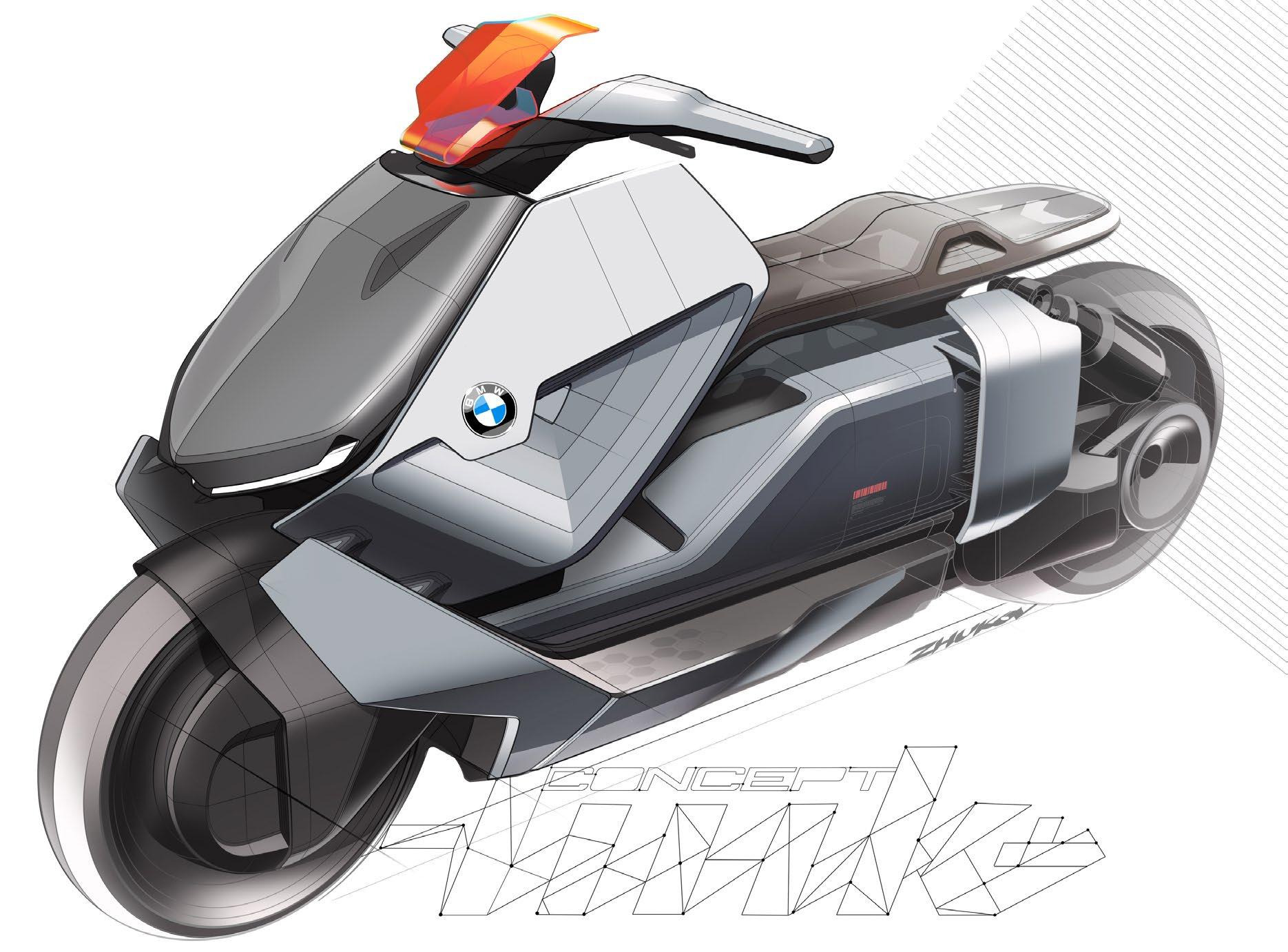

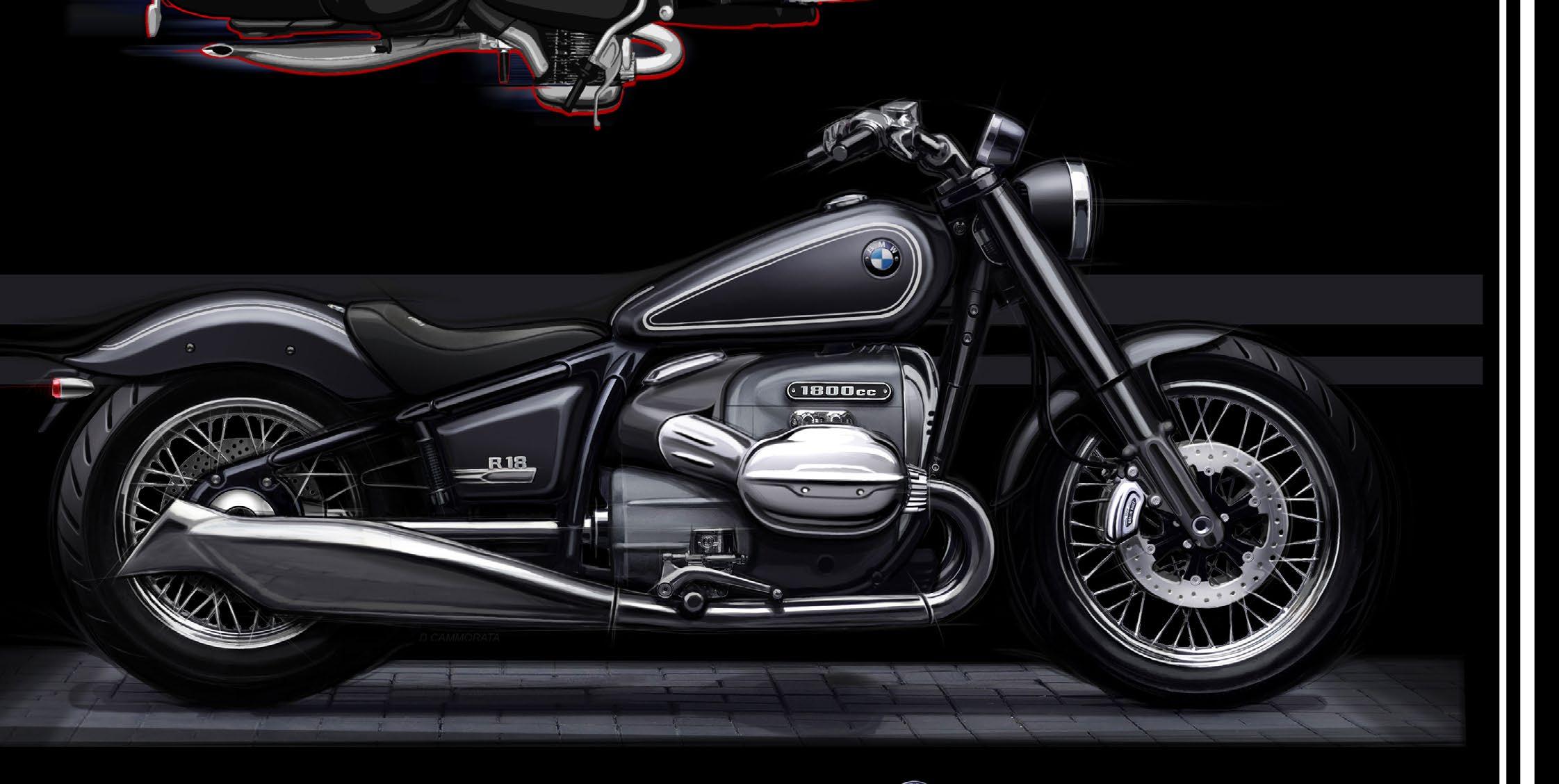



With the introduction in 2022 of the soulful R18, BMW Motorrad finally entered the distinctly American cruiser market long dominated by Harley-Davidson and Indian Motorcycle. BMW had taken a stab at the segment with its short-lived R1200C, built between 1997 and 2004. But the classically inspired R18 brought a whole new panache. BMW’s second bike in its “Heritage” lineup, it has a stripped-down, stretchedout, raked-out, low-slung, purist look that borrows heavily from the iconic 1936 BMW R5.
There being no substitute for displacement in a heavyweight cruiser, the gloss black-painted R18 is powered by the highest capacity boxer engine ever produced. The new air-cooled, four-stroke, twin-cam, fourvalve, flat-twin boxer motor has 9.6:1 compression, displaces 1,802cc (with a 107.1mm bore and 100mm stroke), and produces 91 horsepower and 157Nm (116lb-ft) of low-down torque, plentiful to move the bike’s 345 kg (761 lbs) wet weight with ease. With mammoth deep-finned cylinders, the sparse boxer engine—appearing comically large in its “hardtail” double-cradle steel-tube frame—is the epicenter of the flashback R18 persona. The engine features old-fashioned pushrods (even the original R5 used state-of-the-art chain-driven cams). Gorgeous twin fishtail exhausts are R5-inspired. And in lieu of BMW’s standard Paralever, its nickel-plated driveshaft (connected to a cantilevered monoshock rear end) is exposed, just like the R5.


The M1000RR 50 Years M: Almost 100 years of motorcycle racing spirit and 50 years of motorsport history combined in one exclusive bike.